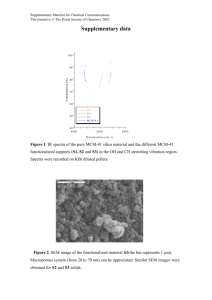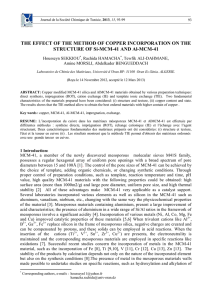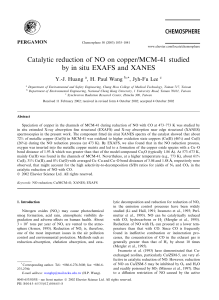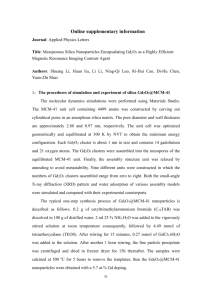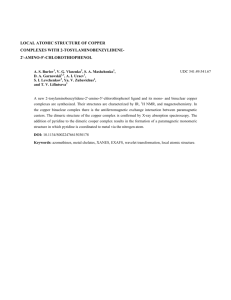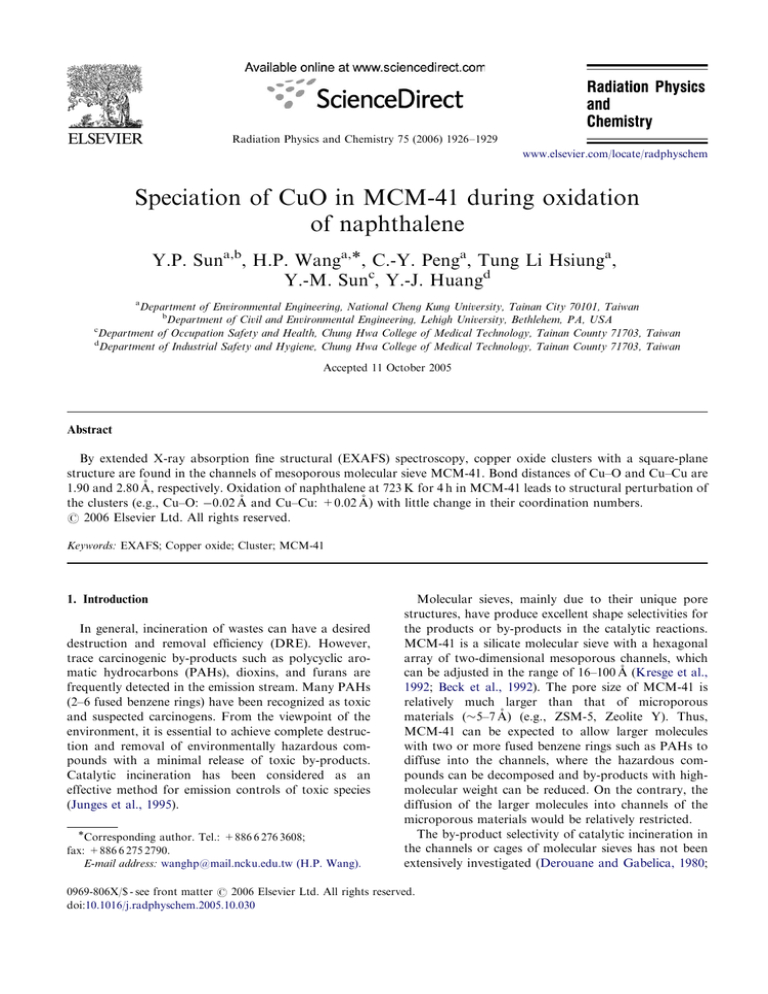
ARTICLE IN PRESS
Radiation Physics and Chemistry 75 (2006) 1926–1929
www.elsevier.com/locate/radphyschem
Speciation of CuO in MCM-41 during oxidation
of naphthalene
Y.P. Suna,b, H.P. Wanga,, C.-Y. Penga, Tung Li Hsiunga,
Y.-M. Sunc, Y.-J. Huangd
a
Department of Environmental Engineering, National Cheng Kung University, Tainan City 70101, Taiwan
b
Department of Civil and Environmental Engineering, Lehigh University, Bethlehem, PA, USA
c
Department of Occupation Safety and Health, Chung Hwa College of Medical Technology, Tainan County 71703, Taiwan
d
Department of Industrial Safety and Hygiene, Chung Hwa College of Medical Technology, Tainan County 71703, Taiwan
Accepted 11 October 2005
Abstract
By extended X-ray absorption fine structural (EXAFS) spectroscopy, copper oxide clusters with a square-plane
structure are found in the channels of mesoporous molecular sieve MCM-41. Bond distances of Cu–O and Cu–Cu are
1.90 and 2.80 Å, respectively. Oxidation of naphthalene at 723 K for 4 h in MCM-41 leads to structural perturbation of
the clusters (e.g., Cu–O: 0.02 Å and Cu–Cu: +0.02 Å) with little change in their coordination numbers.
r 2006 Elsevier Ltd. All rights reserved.
Keywords: EXAFS; Copper oxide; Cluster; MCM-41
1. Introduction
In general, incineration of wastes can have a desired
destruction and removal efficiency (DRE). However,
trace carcinogenic by-products such as polycyclic aromatic hydrocarbons (PAHs), dioxins, and furans are
frequently detected in the emission stream. Many PAHs
(2–6 fused benzene rings) have been recognized as toxic
and suspected carcinogens. From the viewpoint of the
environment, it is essential to achieve complete destruction and removal of environmentally hazardous compounds with a minimal release of toxic by-products.
Catalytic incineration has been considered as an
effective method for emission controls of toxic species
(Junges et al., 1995).
Corresponding author. Tel.: +886 6 276 3608;
fax: +886 6 275 2790.
E-mail address: wanghp@mail.ncku.edu.tw (H.P. Wang).
Molecular sieves, mainly due to their unique pore
structures, have produce excellent shape selectivities for
the products or by-products in the catalytic reactions.
MCM-41 is a silicate molecular sieve with a hexagonal
array of two-dimensional mesoporous channels, which
can be adjusted in the range of 16–100 Å (Kresge et al.,
1992; Beck et al., 1992). The pore size of MCM-41 is
relatively much larger than that of microporous
materials (5–7 Å) (e.g., ZSM-5, Zeolite Y). Thus,
MCM-41 can be expected to allow larger molecules
with two or more fused benzene rings such as PAHs to
diffuse into the channels, where the hazardous compounds can be decomposed and by-products with highmolecular weight can be reduced. On the contrary, the
diffusion of the larger molecules into channels of the
microporous materials would be relatively restricted.
The by-product selectivity of catalytic incineration in
the channels or cages of molecular sieves has not been
extensively investigated (Derouane and Gabelica, 1980;
0969-806X/$ - see front matter r 2006 Elsevier Ltd. All rights reserved.
doi:10.1016/j.radphyschem.2005.10.030
ARTICLE IN PRESS
Y.P. Sun et al. / Radiation Physics and Chemistry 75 (2006) 1926–1929
Chiang et al., 1993). Therefore, the main objective of the
present work was to study speciation of CuO in MCM41 during catalytic oxidation of naphthalene (Nap) by
EXAFS spectroscopy.
2. Experimental methods
Fused silica (Sigma) or rice husk ash (oxidation at
873 K for 16 h) and sodium silicate solution (14%
NaOH, 27% SiO2) were used as silica sources. Aluminum isopropoxide (Fluka) was used to control the Si/Al
ratio of MCM-41. Tetramethylammonium hydroxide
(25%, TMAOH) and cetyltrimethylammonium bromide
(CTMABr) were used as a mineralizer and a template,
respectively, in synthesis of MCM-41. 9.6 g TMAOH
and 23.4 g of CTMABr were dispersed in 100 g of water
with stirring until the solution was clear. 5.67 g of
sodium silicate and 4.52 g of silica or 4.7 g of rice husk
ash and desired amount of aluminum isopropoxide were
added into the solution and stirred for 2 h. The molar
composition of the mother solution was: 1SiO2:
0.27TMAOH: 0.58CTMABr: 86H2O: (0–0.3) Al2O3.
The mother solution was heated at 423 K in a Teflonline autoclave for 48 h. MCM-41 was also synthesized by
the microwave-enhanced method. The as-synthesis
MCM-41 materials were filtered, washed with distilled
water, dried at 343 K for 16 h, and calcined at 813 K for
10 h. Impregnation of 5 wt% of copper onto MCM-41
was conducted by disolving Cu(NO3)2 in water using the
amount equal to the pore volume of the MCM-41
support. The solution was dispersed uniformly on the
support, which was dried at room temperature for 24 h.
The catalysts were then calcined at 813 K for 16 h.
About 250 mg of Cu/MCM-41 (5 wt% Cu supported
on MCM-41) catalysts were placed into a fixed-bed
quartz tube reactor. Saturated vapor of Nap was fed
into the fixed bed with 30 mL/min of nitrogen at
523–723 K, and a desired amount of oxygen was
supplied simultaneously. Products were collected by a
solvent of DCM+hexane (v/v ¼ 1:1). Conversion of the
catalytic oxidation was determined by gas chromatography (GC) equipped with a FID detector. A capillary
column was used in separation constituents in the
product at 423 K.
The EXAFS spectra were collected at a bendingmagnet double-crystal monochromator (DCM) X-ray
beamline at the National Synchrotron Radiation Research Center (NSRRC) of Taiwan. The electron
storage ring was operated with an energy of 1.3 GeV
and a current of 100–200 mA. A Si(1 1 1) DCM was used
for providing highly monochromatized photon beams
with energies of 1–9 keV and an energy resolution of
1.9 104 (eV/eV). Data were collected in fluorescence
mode with a Lytle detector in the region of the Cu K
edge (8978.9 eV) at room temperature. The absorption
1927
spectra were collected using ion chambers that were
filled with helium gas. The photon energy was calibrated
with characteristic pre-edge peaks in the absorption
spectrum of a copper foil. The raw absorption data in
the region of 50–200 eV below the edge position were fit
to a straight line using the least-square algorithms. The
fitted pre-edge background curves were extrapolated
throughout all data range, and subtracted and normalized to minimize the effect of sample thickness. The
near-edge structure in an absorption spectrum covers
the range between the threshold and the point at which
the EXAFS begins. The XANES extend to an energy of
the order of 50 eV above the edge. The k2-weighted and
EXAFS spectra were Fourier transformed to R space
over the range between 2.3 and 10.5 Å1. The EXAFS
data were analyzed using the UWXAFS 3.0 and FEFF
7.0 programs (Yasuda and Takahashi, 1998; Bjørseth,
1983; Kaune et al., 1998; Breck, 1974; Rehr and Stern,
1976; Zabinsky et al., 1995).
3. Results and discussion
Experimental results revealed that CuO/MCM-41
presented a high conversion rate (499.9%) for the
catalytic oxidation of Nap at 723 K. The amount of
carcinogenic polycyclic aromatic hydrocarbons (PAHs)
was dramatically reduced.
In general, XANES spectroscopy can provide the
information of electronic configuration, stereochemistry
and oxidation state of catalytic active species. Fig. 1
shows the XANES spectra of the fresh and used CuO/
MCM-41 in oxidation of Nap at 723 K for 4 h. The preedge XANES spectrum of the fresh CuO/MCM-41
(Fig. 1(a)) presented a very weak absorbance feature for
1s–3d transition, which is forbidden by the selection rule
in the case of perfect octahedral symmetry. The sharp
feature at 8982–8983 eV, which is attributed to the
dipole-allowed 1s–4pxy electron transition, indicated the
existence of Cu(I) in MCM-41. Moreover, the shoulder
at 8984–8986 eV and the intense feature at 8995–8997 eV
can be attributed to the 1s–4pxy transition, suggesting
the existence of Cu(II) species on MCM-41. The upshift
of the edge energy and the very weak absorbance
for 1s–3d forbidden transition near the pre-edge also
confirmed these observations. For the used CuO/MCM41 catalyst, Cu(I) was not observed (in Fig. 1(b)) during
oxidation of Nap at 723 K.
In addition, EXAFS spectra of copper can provide the
information on the atomic arrangement including bond
distance, number of near-neighbors, thermal and static
disorder. The EXAFS spectra were recorded and
analyzed in the k range between 2.7 and 10.5 Å1. An
over 99% reliability of the EXAFS data fitting for
copper species in MCM-41 was obtained. For all the
analyzed EXAFS data, the Debye–Waller factors (Ds2)
ARTICLE IN PRESS
Y.P. Sun et al. / Radiation Physics and Chemistry 75 (2006) 1926–1929
1928
Cu(I)
Normalized absorbance (a.u.)
(a)
(b)
8970
8980
8990
9000
9010
Photon energy (eV)
9020
9030
Fig. 1. XANES spectra of (a) fresh and (b) used CuO/MCM-41 (in oxidation of naphthalene at 723 K for 4 h).
Table 1
Speciation of copper in MCM-41 analyzed by EXAFS
CNa
R (Å)b
Ds2 (Å2)c
CuO/MCM-41
Cu–O
1st
2nd
Cu–Cu
1st
2nd
2.2
1.9
4.5
5.6
1.90
3.61
2.80
4.4
0.003
0.007
0.012
0.015
Used CuO/MCM-41
Cu–O
1st
2nd
Cu–Cu
1st
2nd
2.5
2.2
4.3
5.3
1.88
3.54
2.82
4.46
0.004
0.010
0.014
0.016
Shell
a
CN: coordination number.
R: bond distance.
c
s: Debye–Waller factor.
b
were less than 0.02 Å. Table 1 summarizes structural
parameters of copper extracted from the best-fitted
EXAFS data. In a parallel experiment, we found that
the Cu(II) species has a square-plane structure in the
channels of MCM-41. By combination of EXAFS and
XANES spectroscopic observations, copper oxide clusters might form in the channels of MCM-41, which also
involved in the catalytic oxidation of Nap at 723 K.
Moreover, we found that the copper oxide clusters
possessed Cu–O and Cu–Cu bond distances of 1.90 and
2.80 Å, respectively with coordination number (CN5) of
2.2 and 4.5. However, oxidation of Nap at 723 K for 4 h
on CuO/MCM-41 led to structural perturbation of the
copper oxide clusters. A decrease of Cu–O bond distance
(1.88 Å) and increase of Cu–Cu bond distance (2.82 Å )
were observed.
4. Conclusions
CuO/MCM-41 presented a high conversion rate
(499.9%) for catalytic oxidation of naphthalene
(Nap) at 723 K. Copper oxide clusters with a squareplane structure were found in the channels of the
mesoporous molecular sieve MCM-41. Bond distances
of Cu–O and Cu–Cu in MCM-41 were 1.90 and 2.80 Å,
respectively. The oxidation of Nap at 723 K for 4 h led
to structural perturbation of the copper oxide clusters in
MCM-41.
Acknowledgments
The financial support of the National Science Council,
Taiwan is gratefully acknowledged. We also thank Prof.
Y.W. Yang and Dr. Jyh-Fu Lee of the NSRRC for their
XAS experimental assistance.
Reference
Beck, J.S., Vartuli, J.C., Roth, W.J., Leonowicz, M.E., Kresge,
C.T., Schmitt, K.D., Chu, C.T.W., Olson, H.D., Sheppard,
ARTICLE IN PRESS
Y.P. Sun et al. / Radiation Physics and Chemistry 75 (2006) 1926–1929
E.W., McCullen, S.B., Higgins, J.B., Schlenker, J.L., 1992.
A new family of mesoporous molecular sieves prepared with
liquid crystal templates. J. Am. Chem. Soc. 114,
10834–10843.
Bjørseth, A., 1983. Hankbook of Polycyclic Aromatic Hydrocarbons, 2nd ed. Marcel Dekker, New York, pp. 34–65.
Breck, D.W., 1974. Zeolite Molecular Sieves, 1st ed. Wiley,
New York, pp. 634.
Chiang, A.S.T., Lin, K.S., Fan, L.Y., 1993. Fundamentals of
Adsorption. Kodansha, Tokyo, pp. 81.
Derouane, E.G., Gabelica, Z.A., 1980. Novel effect of shape
selectivity: molecular control in Zeolite ZSM-5. J. Catal. 65,
486–493.
Junges, U., Jacobs, W., Voigt-Martin, I., Krutzsch, B., Schuth,
F., 1995. MCM-41 as a support for small platinum particles:
a catalust for low-termperature carbon monoxide oxidation.
J. Chem. Soc. Chem. Commun. 2283.
Kaune, A., Lenoir, D., Schramm, K.W., Zimmermann, R.,
Kettrup, A., Jaeger, K., ruckel, H.G., Frank, F., 1998.
1929
Chlorobenzenes and chlorophenols as indicator parameters
for chlorinated dibenzodioxins and dibenofurans in incineration processes: influence of various facilities and sampling points. Environ. Eng. Sci. 15, 85–95.
Kresge, C.T., Leonowice, M.E., Roth, W.J., Vartuli, J.C., Beck,
J.S., 1992. Order mesoporous molecular sieves synthesized
by a liquid-crystal template mechanism. Nature 359,
710–712.
Rehr, J.J., Stern, E.A., 1976. Multiple-scattering corrections to
the extended X-ray absorption fine structure. Phys. Rev. B
14, 4413.
Yasuda, K., Takahashi, M., 1998. The emission of polycyclic
aromatic-hydrocarbons from municipal solid-waste incinerators during the combustion cycle. J. Air Waste Manage.
Assoc. 48, 441.
Zabinsky, S.I., Rehr, J.J., Ankudinov, A., Albers, R.C., Eller,
M., 1995. Multiple-scattering calculations of X-ray absorption spectra. J. Phys. Rev. B Condens. Matter 52,
2995–3009.

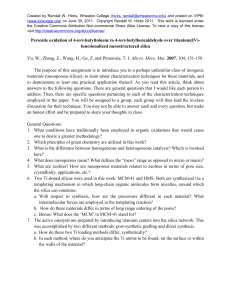
![Coordination state of Cu+ ions in Cu-[Al]MCM-41](http://s2.studylib.net/store/data/018680249_1-9277e46c5f24c2bfb628b40764a9612b-300x300.png)
